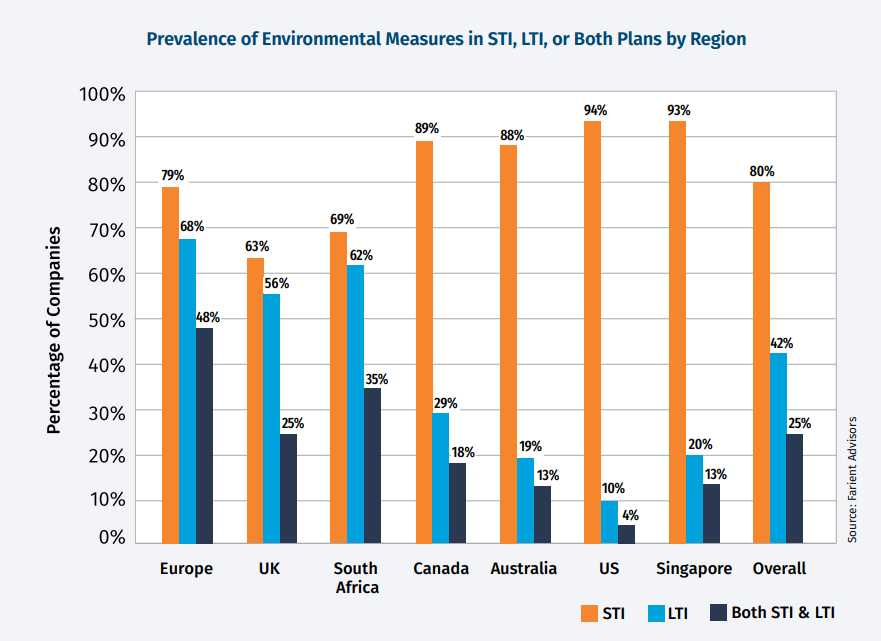
|
Listen to this article.
Getting your Trinity Audio player ready...
|
Insights by Dr Chris Blair
“In this article, we take a deep dive into one ESG dimension: climate. What metrics are companies using to measure their progress on climate mitigation? To what extent are they leveraging their remuneration systems to elevate performance in this area? How do corporate approaches differ by industry or geography? This article synthesises the key themes of the issues while offering a critical perspective on the challenges and opportunities in corporate climate incentives.
“The fight against climate change is increasingly intertwined with corporate accountability, as stakeholders push companies to align executive incentives with environmental goals. The 2025 GECN Global Trends in Stakeholder Incentives Report paints a complex picture of global efforts to use executive pay as a lever for environmental action (https://www.21century.co.za/wp-content/uploads/2025/01/2025-21st-Century-GECN-Global-Climate_Report-compressed.pdf). This article delves into key themes from the report, particularly the paradox of incentives not driving significant emissions reductions, disparities in global and regional approaches, and the tension between short-term incentives (STIs) and long-term climate goals.
Environmental Measures vs. Emissions Reduction: A Disconnect?
“One of the stark findings of the research is the disjunction between the proliferation of environmental measures and their actual impact on emissions. While 65% of global companies now incorporate environmental measures into their incentive programs, only 46% of companies reported a decrease in emissions over the past year. Even more striking, incentive payouts averaged 119% of the target, suggesting executives may be rewarded even when emissions increaseor perhaps executives are being rewarded for increasing emissions more slowly.

Incentives: Short-Term vs. Long-Term
“Despite the long-term nature of emissions reduction goals, most companies rely heavily on STIs to drive climate action. The report reveals that 80% of companies use environmental incentives in STIs, while only 42% incorporate them into LTIs. This is particularly problematic given that climate targets, including net-zero aspirations, are set for horizons like 2050. Paying executives for short-term actions risks creating a mismatch between immediate activities and the long-term outcomes needed to combat climate change.
“The regional breakdown is equally revealing. European and UK companies lead in incorporating LTIs, with 68% and 56% respectively, compared to just 10% in the US. This divergence reflects cultural differences in executive compensation structures and a greater emphasis on sustainability in regions with stricter regulatory frameworks.
The Paradoxes of Climate Incentives
“Proliferation Without Impact – there is a paradox of increasing environmental measures but limited emissions reductions. This could stem from, namely, low baseline ambition, where goals often focus on easily achievable milestones; measurement complexity, where many companies struggle with Scope 3 emissions, which involve upstream and downstream activities and are difficult to quantify; and short-termism, where incentives frequently emphasise immediate disclosures or initial steps rather than sustained reductions.
“The Incentive Misalignment—A deeper misalignment emerges when we juxtapose the timelines of climate goals with incentive structures. Climate change is a marathon requiring systemic shifts, yet most incentive programs are sprints. This creates a perverse dynamic where executives may prioritise short-term wins over the systemic changes needed to meet 2050 goals.
“Regional Inequalities—Regions like Europe and the UK have outpaced others in embedding rigorous environmental targets within incentive frameworks. 94% of UK companies disclose net-zero commitments, compared to just 60% in Canada. South Africa sits in the middle of this spectrum, grappling with economic and infrastructural challenges that impede large-scale decarbonisation efforts.

Bridging the Gaps
“The following recommendations should bridge the gaps highlighted in this article.
“Shift from Activity to Outcome-Based Goals: The current reliance on activity-based incentives—such as emissions disclosures—must evolve toward outcome-based systems. Targets should be tied to absolute emissions reductions rather than intermediary steps. Companies must also set ambitious yet achievable thresholds to balance investor expectations with operational realities.
“Embed Long-Term Incentives: To align with the temporal nature of climate goals, corporations should integrate environmental measures into LTIs. This ensures accountability over multi-year periods and aligns executive priorities with the 2050 targets. LTIs could include performance conditions based on net-zero milestones, Scope 3 reduction strategies, or energy transitions.
“Regional Collaboration and Knowledge Sharing: Regions like South Africa and US can benefit from collaboration with Europe and the UK to adapt successful strategies for local contexts. Developing tailored policies that account for regional nuances—such as energy dependency or economic structure—can drive more effective climate action.
“Enhance Transparency and Accountability: Greater transparency around incentive structures and their alignment with climate goals is crucial. Stakeholders need clear metrics to evaluate progress, such as science-based targets or third-party certifications like the Science Based Targets initiative (SBTi).
“Build Capacity for Scope 3 Emissions: As the most challenging aspect of emissions measurement, Scope 3 demands more robust frameworks and collaboration across value chains. Companies must invest in data systems, supplier partnerships, and standardised methodologies to effectively track and reduce Scope 3 emissions.
“The 2025 GECN research underscores the urgency of refining corporate climate incentives to align with the scale of the climate crisis. While progress is evident in the growing adoption of environmental measures, significant gaps remain. Misaligned incentives, regional disparities, and a skewed focus on short-term achievements pose barriers to meaningful climate action.
“As we approach critical climate deadlines, the corporate world must recalibrate its strategies. By shifting toward long-term, outcome-driven incentives and fostering global collaboration, businesses can play a pivotal role in mitigating climate change. The stakes are high, and the time for bold, systemic action is now.”
This article is based on research conducted by Dr Blair, CEO of 21st Century (www.21century.co.za) through collaboration with our multinational reach, the GECN Group. This is the fifth consecutive report by the GECN Group to study remuneration trends that focus exclusively on ESG incentives. Please contact us at [email protected] for any further information.
Written by:
Dr Chris Blair, CEO of 21st Century, [email protected]
B.Sc. Chem. Eng., MBA – Leadership & Sustainability, PhD – Leadership & Management
Share via:




















